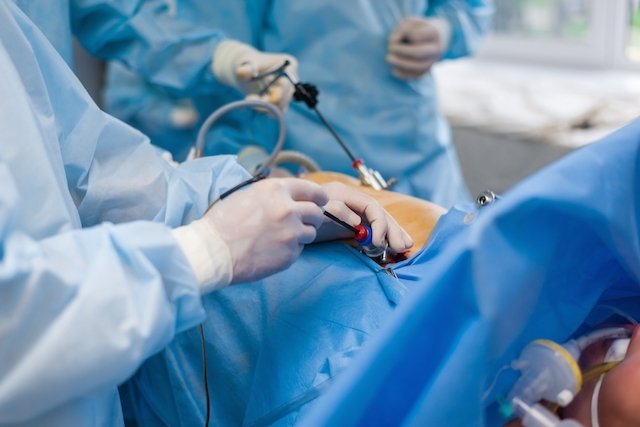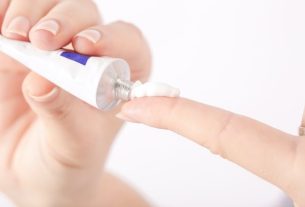Gallbladder surgery is mainly indicated in the case of gallstones, and its main objective is to remove the gallbladder, requiring general anesthesia to do so.
Gallbladder surgery, also called cholecystectomy, is most often performed on a scheduled basis and can also be performed urgently, especially when there are associated symptoms, such as colic and intense pain, as it can be a sign of inflammation and/or or infection, requiring surgery to prevent complications.
It is possible that after surgery the person may feel discomfort in the abdominal region, which is considered normal, and the doctor may recommend the use of anti-inflammatory medications. Furthermore, it is recommended that the person rest for 1 to 2 weeks and have a liquid or soft diet.

When is it indicated
Surgery to remove the gallbladder may be indicated in the following situations:
- Presence of gallstones;
- Tumor in the bile ducts;
- Gallbladder infection;
- Damage to the blood vessels radiating the gallbladder.
This surgery may also be indicated when the presence of polyps and/or changes in this organ that are indicative of cancer is verified.
Preparation for gallbladder surgery
Before gallbladder surgery, tests are normally requested in order to assess the person’s general health status, the characteristics of the gallbladder and nearby organs and ensure that the surgery is safe. Thus, a blood count, coagulogram and electrocardiogram can be performed.
It is also recommended that in the weeks before surgery, the person eats a lighter diet and avoids smoking and drinking alcohol to prevent inflammation of the organ. On the day of surgery, it is recommended that the person fast for 8 hours to prevent side effects related to anesthesia.
How it is made
Surgery can be done in 2 ways:
- Conventional surgery, or with a cut, also known as open surgery: performed through a larger cut in the abdomen, to remove the gallbladder. It usually takes a little longer to recover, and leaves a more visible scar;
- Laparoscopic surgeryor by video: it is performed with 4 holes in the abdomen, through which the doctor passes the material and a small camera to perform the surgery with less manipulation and fewer cuts, resulting in a faster recovery surgery, with less pain and a smaller scar .
Both surgeries are performed under general anesthesia and usually require only 1 to 2 days of hospitalization. However, if the abdomen is very swollen, as happens in some complications caused by gallstones, such as cholangitis or pancreatitis, it may take longer to recover.
If it is necessary to rest in bed for more than 3 days, the doctor may recommend that physiotherapy be carried out while still in the hospital to ensure good body movement and to prevent respiratory complications that can occur after any surgery. See the recommended exercises to avoid respiratory complications.
What is the post-operative period like?
After the anesthesia and painkillers wear off, the person may feel slight pain or discomfort in the abdominal region, which may also radiate to the shoulder or neck region. As long as the pain persists, the doctor will recommend the use of analgesics or anti-inflammatories, such as Dipyrone or Ketoprofen, for example.
1. How much rest time is needed
After surgery to remove the gallbladder, initial rest is recommended, but as soon as you are able to get up, after 1 to 2 days, you can take short walks and activities without straining. Returning to work, as well as other day-to-day activities, such as driving or doing light exercise, should only be started after 1 week, in the case of laparoscopy surgery, or after 2 weeks, in the case of conventional surgery.
It is also important to avoid sitting or lying down for a long time and, therefore, you should take short walks around the house throughout the day. However, each case may vary, so it is important to follow the doctor’s instructions.
2. What is the diet like
In the first few days, a liquid or soft diet is recommended and care is taken not to move excessively, thus ensuring good healing of the surgical wound. Afterwards, the diet will become normal, but it is recommended that it be low in fat, so the patient should avoid eating sausages or fried foods, for example.
Check out the video below for more details on how to eat after having your gallbladder removed:
Surgery to remove the gallbladder has nothing to do with weight loss, so although the person may lose weight, it is due to the low-fat diet they must follow after surgery. With the removal of the gallbladder, the bile that is produced in the liver will continue to be produced, but instead of being stored in the gallbladder, it immediately goes to the intestine to eliminate fat from food and not fat from the body.
Possible risks of surgery
The risks of gallbladder surgery are minimal, however the most serious are bile duct damage, hemorrhage or infection that can occur with any surgical intervention.
Therefore, it is advisable to go to the emergency room immediately if you have a fever above 38ºC, if the surgical wound is full of pus, if the skin and eyes turn yellow, or if you experience shortness of breath, vomiting or pain that does not improve with treatment. medicines prescribed by the doctor.

Sign up for our newsletter and stay up to date with exclusive news
that can transform your routine!
Warning: Undefined array key "title" in /home/storelat/public_html/wp-content/plugins/link-whisper-premium/templates/frontend/related-posts.php on line 12
Warning: Undefined array key "title_tag" in /home/storelat/public_html/wp-content/plugins/link-whisper-premium/templates/frontend/related-posts.php on line 13



